Search Result
Results for "
conjunctivitis
" in MedChemExpress (MCE) Product Catalog:
5
Isotope-Labeled Compounds
| Cat. No. |
Product Name |
Target |
Research Areas |
Chemical Structure |
-
- HY-17428
-
|
|
Histamine Receptor
Endogenous Metabolite
|
Inflammation/Immunology
Endocrinology
|
|
Tripelennamine hydrochloride, an ethylenediamine derivative, is a potent histamine H1-receptor antagonist. Tripelennamine hydrochloride lessens the allergic response of the organism caused by histamine. Tripelennamine hydrochloride can be used for the research of rhinitis, conjunctivitis, and allergic and anaphylactic reactions .
|
-
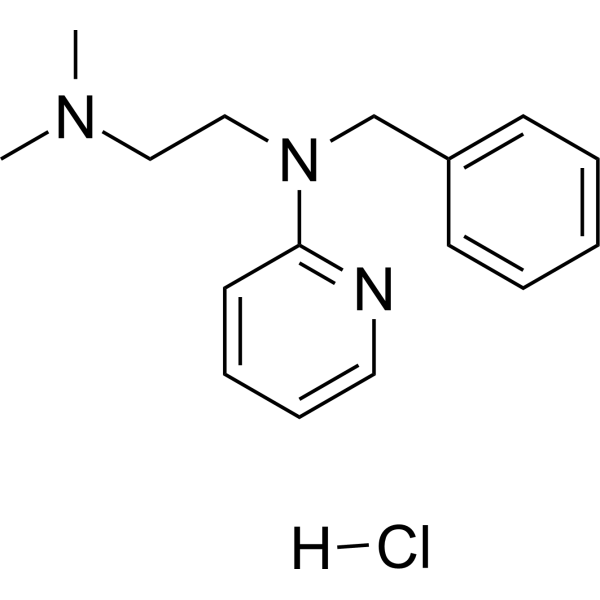
-
- HY-108411
-
|
|
Histamine Receptor
|
Inflammation/Immunology
|
|
Emedastine is an orally active, selective and high affinity histamine H1 receptor antagonist with a Ki value of 1.3 nM. Emedastine is a benzimidazole derivative with potent antiallergic properties and used for allergic rhinitis, allergic skin diseases and allergic conjunctivitis .
|
-

-
- HY-I0021
-
|
|
Histamine Receptor
|
Inflammation/Immunology
Endocrinology
|
|
Bepotastine is a selective and orally active second-generation histamine H1 receptor antagonist, can suppress the expression of nerve growth factor (NGF). Bepotastine has the potential for allergic rhinitis, allergic conjunctivitis and urticaria/pruritus research .
|
-
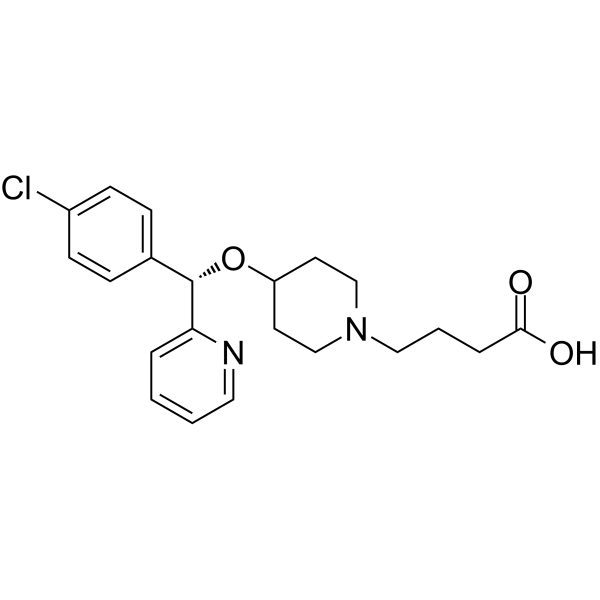
-
- HY-17428A
-
-
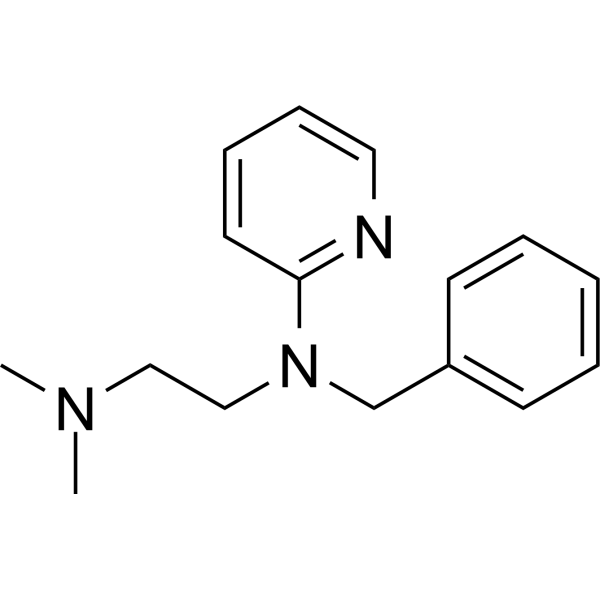
-
- HY-17428B
-
|
|
Histamine Receptor
Endogenous Metabolite
|
Inflammation/Immunology
Endocrinology
|
|
Tripelennamine citrate, an ethylenediamine derivative, is a potent histamine H1-receptor antagonist. Tripelennamine citrate lessens the allergic response of the organism caused by histamine. Tripelennamine citrate can be used for the research of rhinitis, conjunctivitis, and allergic and anaphylactic reactions .
|
-

-
- HY-B2178
-
|
|
Histamine Receptor
|
Inflammation/Immunology
|
|
Emedastine difumarate is an orally active, selective and high affinity histamine H1 receptor antagonist with a Ki value of 1.3 nM. Emedastine difumarate is a benzimidazole derivative with potent antiallergic properties and used for allergic rhinitis, allergic skin diseases and allergic conjunctivitis .
|
-

-
- HY-I0021A
-
|
|
Histamine Receptor
|
Inflammation/Immunology
Endocrinology
|
|
Bepotastine tosylate is a selective and orally active second-generation histamine H1 receptor antagonist. Bepotastine tosylate can suppress the expression of nerve growth factor (NGF). Bepotastine tosylate can be used in studies of allergic rhinitis, allergic conjunctivitis and urticaria/pruritus .
|
-
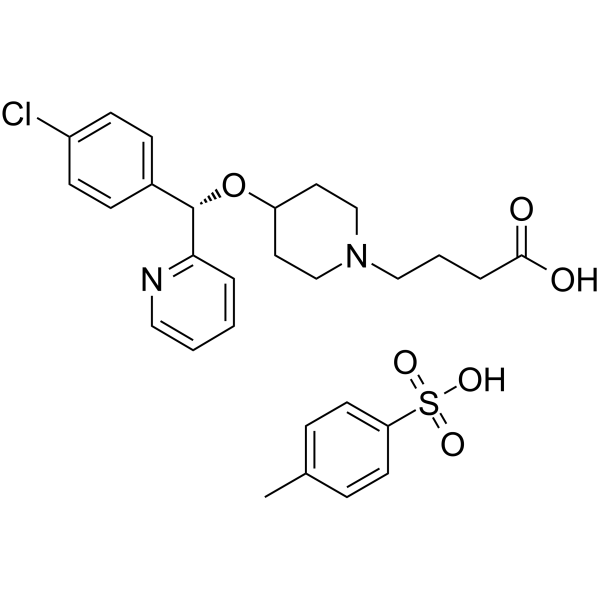
-
- HY-A0015
-
|
|
Histamine Receptor
|
Inflammation/Immunology
Endocrinology
|
|
Bepotastine besilate is a selective and orally active second-generation histamine H1 receptor antagonist, can suppress the expression of nerve growth factor (NGF). Bepotastine besilate has the potential for allergic rhinitis, allergic conjunctivitis and urticaria/pruritus research .
|
-
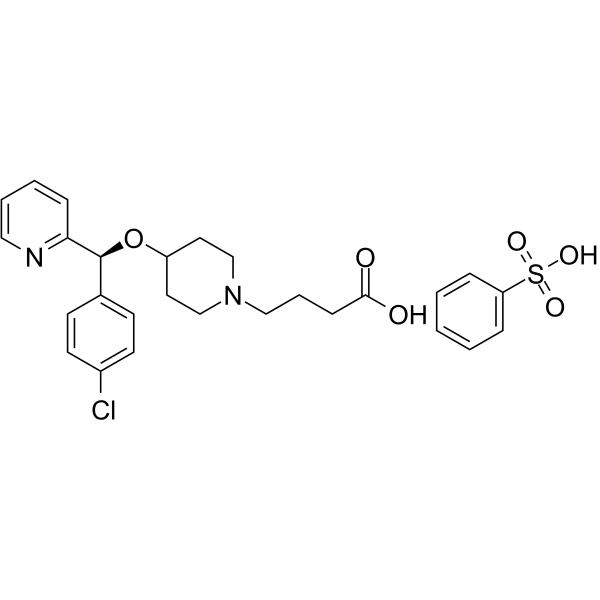
-
- HY-111326
-
-
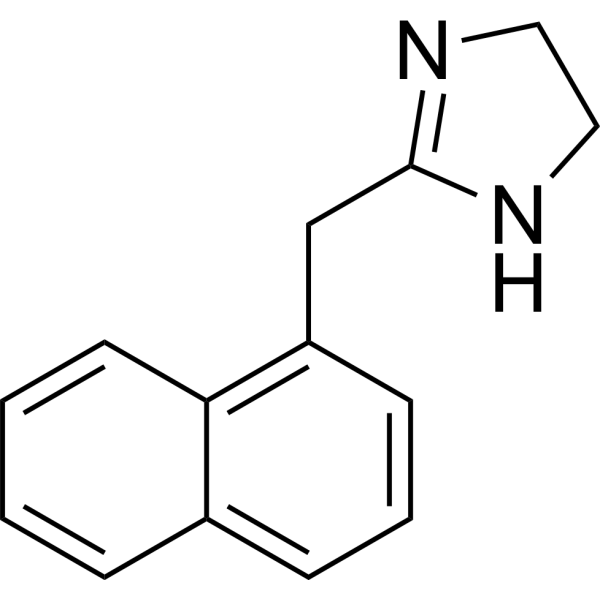
-
- HY-W062109
-
|
|
Endogenous Metabolite
Histamine Receptor
|
Inflammation/Immunology
|
|
Olopatadine is an orally active and selective histamine 1 (H1) receptor antagonist and a mast cell stabilizer. Olopatadine prevents immunologically stimulated pro-inflammatory mediator release from human conjunctival mast cells. Olopatadine can be used for researching allergic conjunctivitis .
|
-
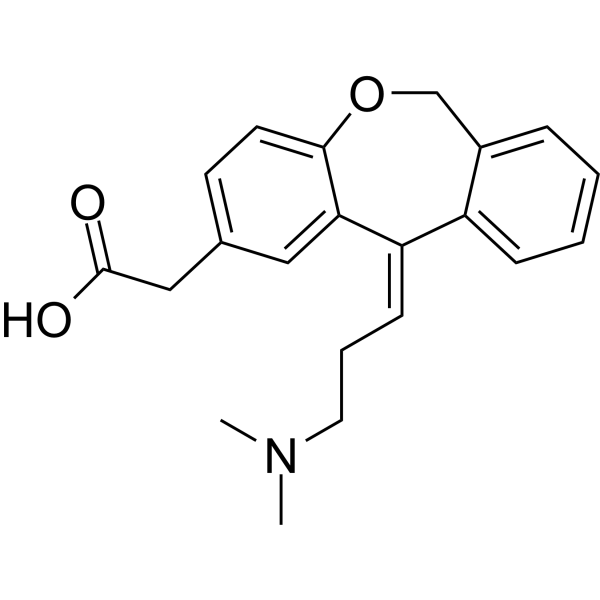
-
- HY-14277A
-
|
R 50547 hydrochloride
|
Histamine Receptor
Neurotensin Receptor
Integrin
|
Inflammation/Immunology
|
|
Levocabastine (R 50547) hydrochloride is a potent and selective histamine H1-receptor antagonist. Levocabastine hydrochloride is also a selective, high affinity neurotensin receptor subtype 2 (NTR2) antagonist, with a Ki of 17 nM for mNTR2. Levocabastine hydrochloride can act as a VLA-4 antagonist, interferes with conjunctival eosinophil infiltration in allergic conjunctivitis (AC) .
|
-
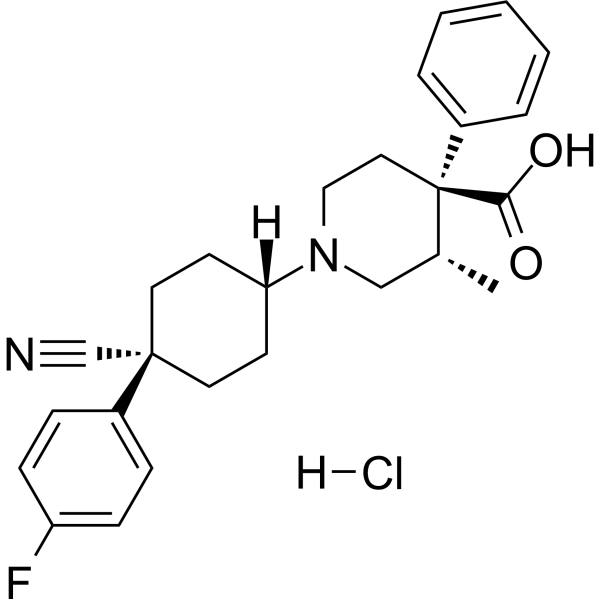
-
- HY-14277
-
|
R 50547
|
Histamine Receptor
Neurotensin Receptor
Integrin
|
Inflammation/Immunology
|
|
Levocabastine (R 50547) is a potent and selective histamine H1-receptor antagonist. Levocabastine hydrochloride is also a selective, high affinity neurotensin receptor subtype 2 (NTR2) antagonist, with a Ki of 17 nM for mNTR2. Levocabastine can act as a VLA-4 antagonist, interferes with conjunctival eosinophil infiltration in allergic conjunctivitis (AC) .
|
-
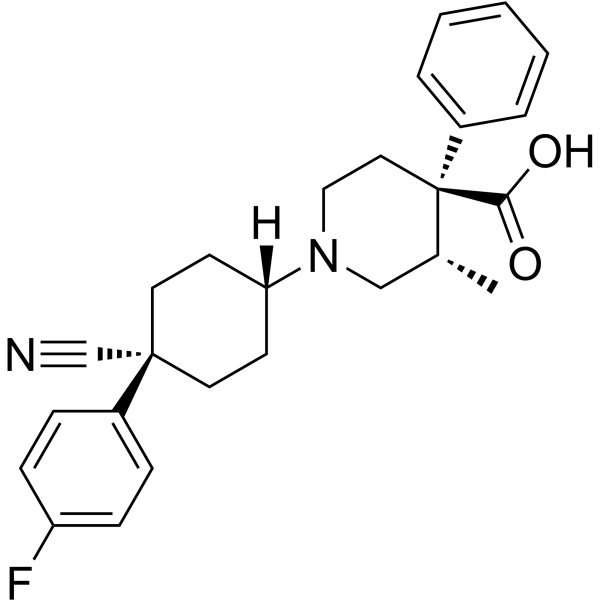
-
- HY-111326A
-
-
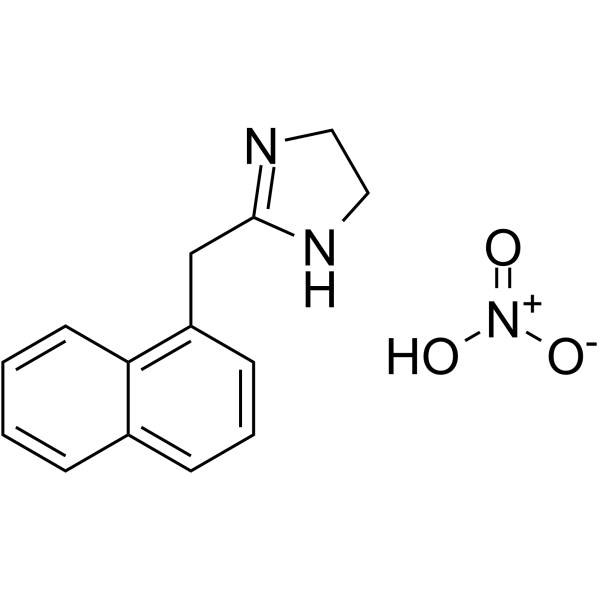
-
- HY-119995
-
|
|
Apoptosis
Histamine Receptor
|
Cardiovascular Disease
Cancer
|
|
Chloropyramine is competitive reversible H1 receptor antagonist. Chloropyramine also has anti-tumour activity in breast cancer. Chloropyramine can be used for the research of allergic conditions, such as conjunctivitis and bronchial asthma .
|
-
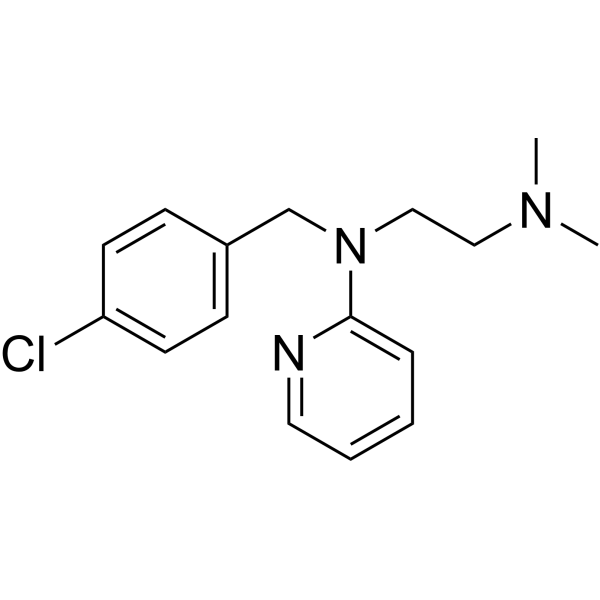
-
- HY-A0015A
-
|
|
Others
|
Inflammation/Immunology
Endocrinology
|
|
(Rac)-Bepotastine (besilate) is the isomer of Bepotastine (besilate) (HY-A0015), and can be used as an experimental control. Bepotastine besilate is a selective and orally active second-generation histamine H1 receptor antagonist, can suppress the expression of nerve growth factor (NGF). Bepotastine besilate has the potential for allergic rhinitis, allergic conjunctivitis and urticaria/pruritus research .
|
-
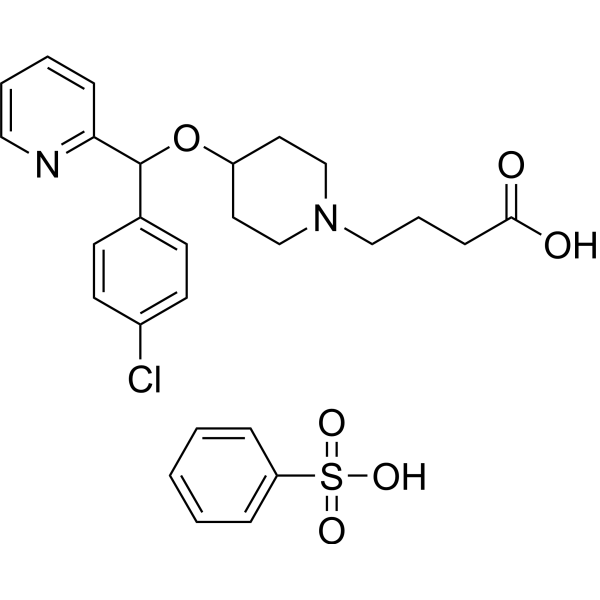
-
- HY-B0446
-
|
Naphthazoline hydrochloride
|
Adrenergic Receptor
TNF Receptor
Interleukin Related
VEGFR
|
Cardiovascular Disease
Inflammation/Immunology
|
|
Naphazoline (Naphthazoline) hydrochloride is a potent α-adrenergic receptor agonist. Naphazoline hydrochloride reduces vascular hyperpermeability and promotes vasoconstriction. Naphazoline hydrochloride reduces the levels of inflammatory factors (TNF-α, IL-1β and IL-6), cytokines (IFN-γ and IL-4), IgE, GMCSF, and NGF。Naphazoline hydrochloride can be used for non-bacterial conjunctivitis research .
|
-
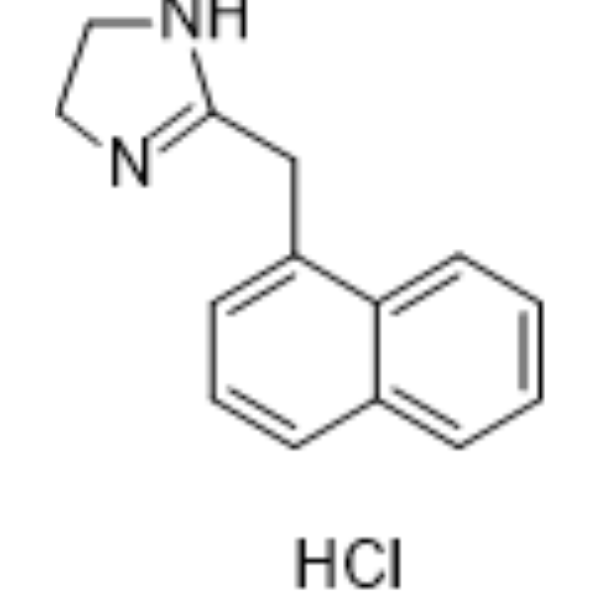
-
- HY-B0426AS
-
-
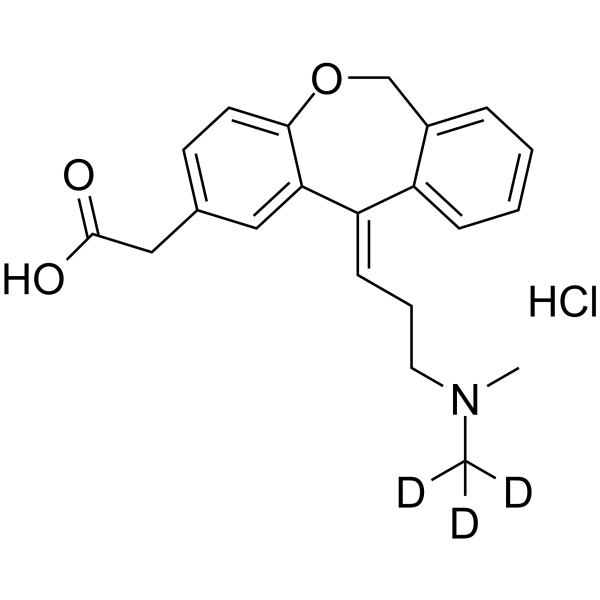
-
- HY-10581A
-
|
AM-1155 hydrochloride; BMS-206584 hydrochloride; PD135432 hydrochloride
|
Bacterial
Topoisomerase
Antibiotic
|
Infection
|
|
Gatifloxacin hydrochloride (AM-1155; BMS-206584; PD135432) is a potent fluoroquinolone antibiotic with broad-spectrum antibacterial activity. Gatifloxacin hydrochloride inhibits bacterial type II topoisomerases (IC50=13.8 μg/ml for S. aureus topoisomerase IV) and E. coli DNA gyrase (IC50 = 0.109 μg/ml) . Gatifloxacin hydrochloride can be used to treat bacterial conjunctivitis in vivo.
|
-
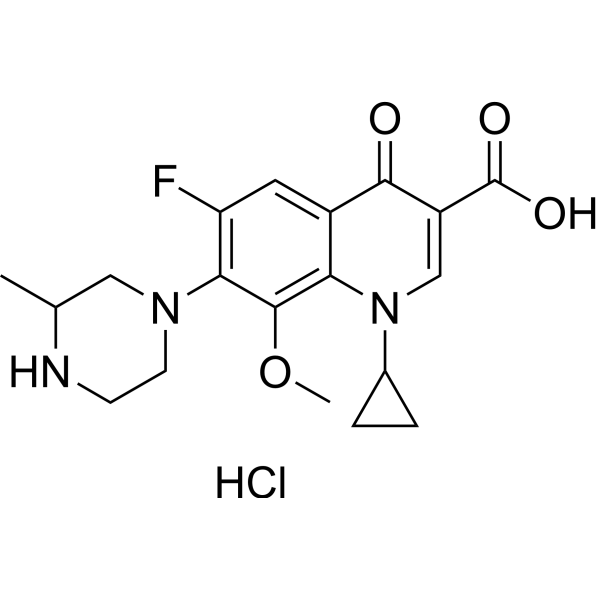
-
- HY-10581B
-
|
AM-1155 mesylate; BMS-206584 mesylate; PD135432 mesylate
|
Bacterial
Topoisomerase
Antibiotic
|
Infection
|
|
Gatifloxacin mesylate (AM-1155; BMS-206584; PD135432) is a potent fluoroquinolone antibiotic with broad-spectrum antibacterial activity. Gatifloxacin mesylate inhibits bacterial type II topoisomerases (IC50=13.8 μg/ml for S. aureus topoisomerase IV) and E. coli DNA gyrase (IC50 = 0.109 μg/ml) . Gatifloxacin mesylate can be used to treat bacterial conjunctivitis in vivo.
|
-
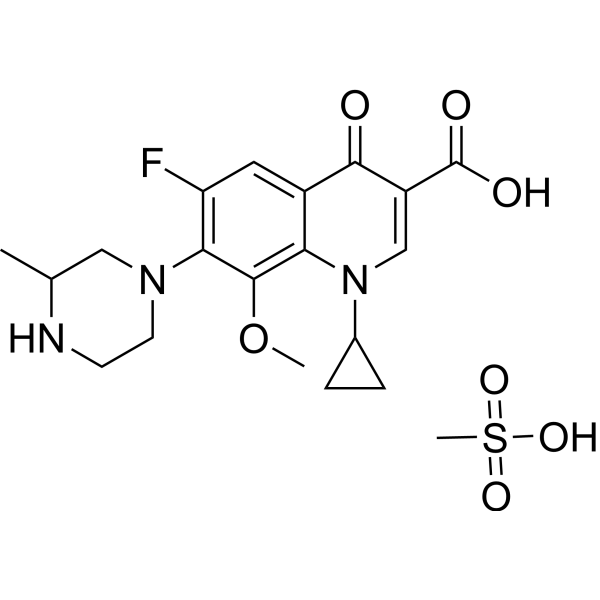
-
- HY-10581
-
|
AM-1155; BMS-206584; PD135432
|
Bacterial
Topoisomerase
Antibiotic
|
Infection
|
|
Gatifloxacin (AM-1155; BMS-206584; PD135432) is a potent fluoroquinolone antibiotic with broad-spectrum antibacterial activity. Gatifloxacin inhibits bacterial type II topoisomerases (IC50=13.8 μg/ml for S. aureus topoisomerase IV) and E. coli DNA gyrase (IC50=0.109 μg/ml) . Gatifloxacin can be used to treat bacterial conjunctivitis in vivo.
|
-

-
- HY-10581C
-
|
AM-1155 sesquihydrate; BMS-206584 sesquihydrate; PD135432 sesquihydrate
|
Bacterial
Topoisomerase
Antibiotic
|
Infection
Inflammation/Immunology
|
|
Gatifloxacin sesquihydrate (AM-1155; BMS-206584; PD135432) is a potent fluoroquinolone antibiotic with broad-spectrum antibacterial activity. Gatifloxacin sesquihydrate inhibits bacterial type II topoisomerases (IC50=13.8 μg/ml for S. aureus topoisomerase IV) and E. coli DNA gyrase (IC50 = 0.109 μg/ml) . Gatifloxacin sesquihydrate can be used to treat bacterial conjunctivitis in vivo.
|
-
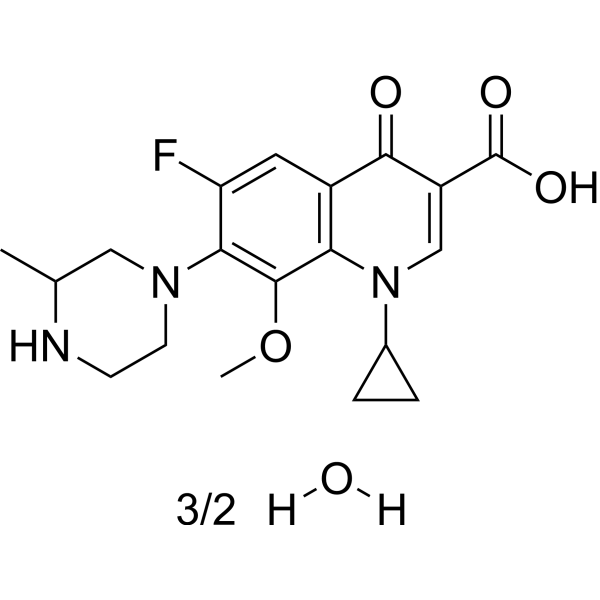
-
- HY-B0426A
-
-
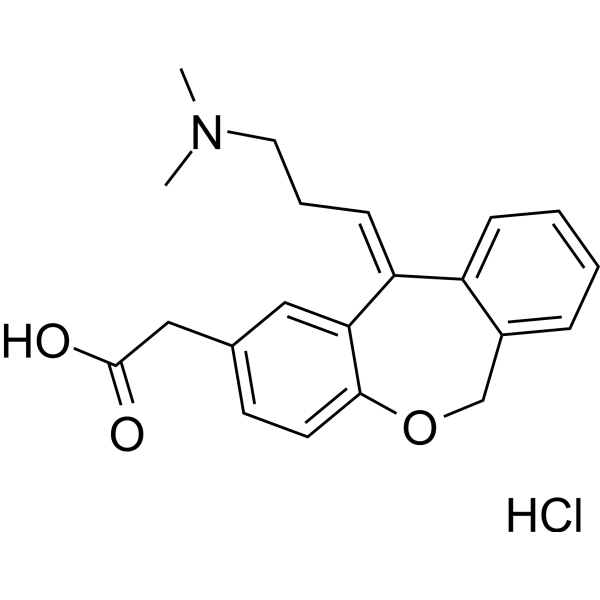
-
- HY-B0580
-
|
RS37619
|
COX
Apoptosis
|
Inflammation/Immunology
Cancer
|
|
Ketorolac (RS37619) is a non-steroidal anti-inflammatory drug (NSAID), acting as a nonselective COX inhibitor, with IC50s of 20 nM for COX-1 and 120 nM for COX-2. Ketorolac tromethamine is used as 0.5% ophthalmic solution for the research of allergic conjunctivitis, cystoid macular edema, intraoperative miosis, and postoperative ocular inflammation and pain. Ketorolac tromethamine is also a DDX3 inhibitor that can be used for cancer research .
|
-

-
- HY-B0580C
-
|
RS37619 hemicalcium
|
COX
Apoptosis
|
Inflammation/Immunology
Cancer
|
|
Ketorolac (RS37619) hemicalcium is a non-steroidal anti-inflammatory drug (NSAID), acting as a nonselective COX inhibitor, with IC50s of 20 nM for COX-1 and 120 nM for COX-2. Ketorolac tromethamine is used as 0.5% ophthalmic solution for the research of allergic conjunctivitis, cystoid macular edema, intraoperative miosis, and postoperative ocular inflammation and pain. Ketorola chemicalcium is also a DDX3 inhibitor that can be used for cancer research .
|
-
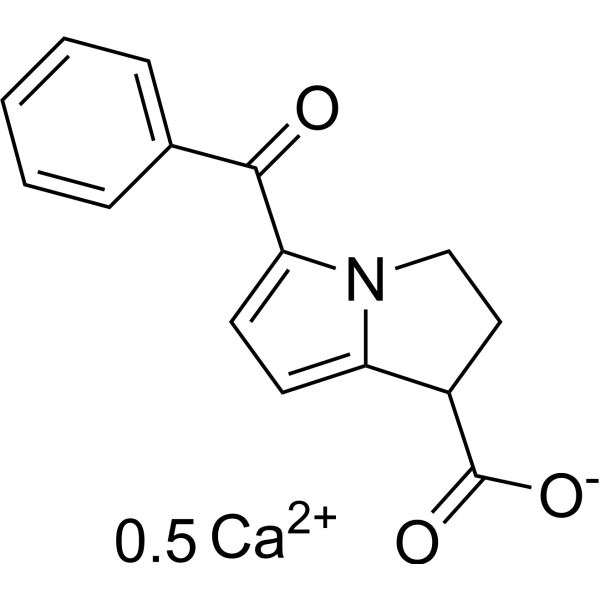
-
- HY-108411S
-
|
|
Isotope-Labeled Compounds
Histamine Receptor
|
Inflammation/Immunology
|
|
Emedastine- 13C,d3 (fumarate) is the 13C- and deuterium labeled Emedastine. Emedastine is an orally active, selective and high affinity histamine H1 receptor antagonist with a Ki value of 1.3 nM. Emedastine is a benzimidazole derivative with potent antiallergic properties and used for allergic rhinitis, allergic skin diseases and allergic conjunctivitis[1][2][3].
|
-
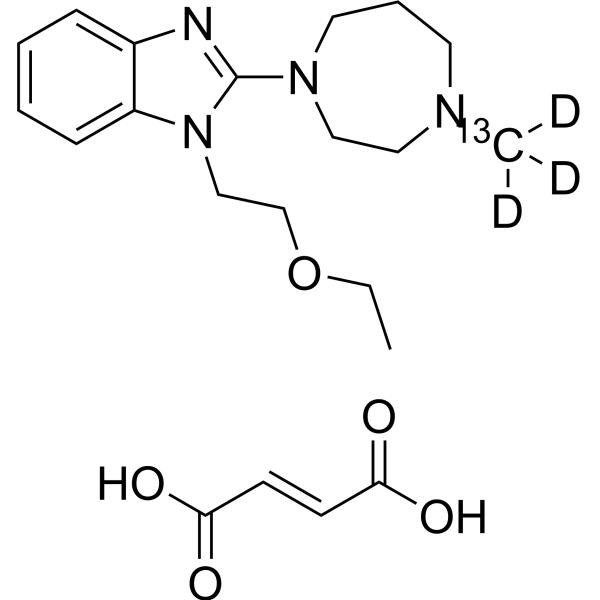
-
- HY-W062109S
-
|
|
Histamine Receptor
Endogenous Metabolite
|
Inflammation/Immunology
|
|
Olopatadine-d6 is the deuterium labeled Olopatadine[1]. Olopatadine is an orally active and selective histamine 1 (H1) receptor antagonist and a mast cell stabilizer. Olopatadine prevents immunologically stimulated pro-inflammatory mediator release from human conjunctival mast cells. Olopatadine can be used for researching allergic conjunctivitis[2][3].
|
-
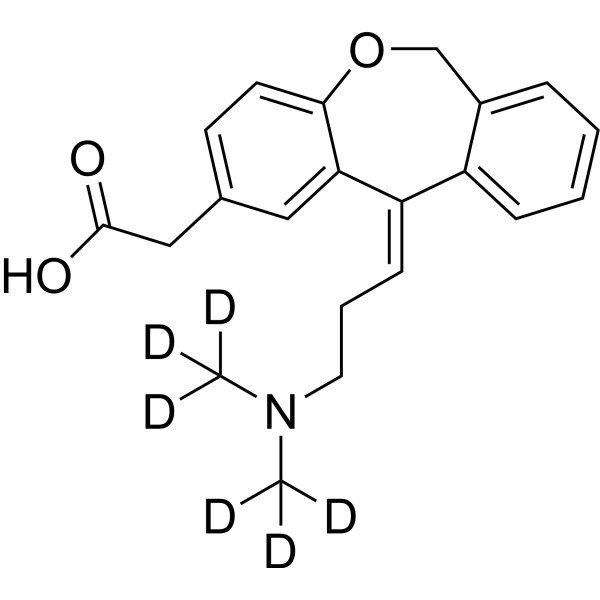
-
- HY-14270
-
-
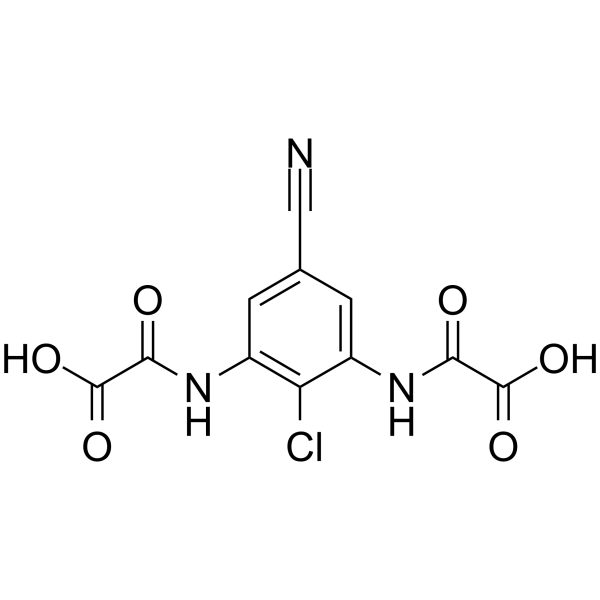
-
- HY-137863
-
|
|
Others
|
Inflammation/Immunology
|
|
Pemirolast is an orally active antiallergic agent. Pemirolast attenuates paclitaxel hypersensitivity reactions, can be used for bronchial asthma and conjunctivitis research - .
|
-
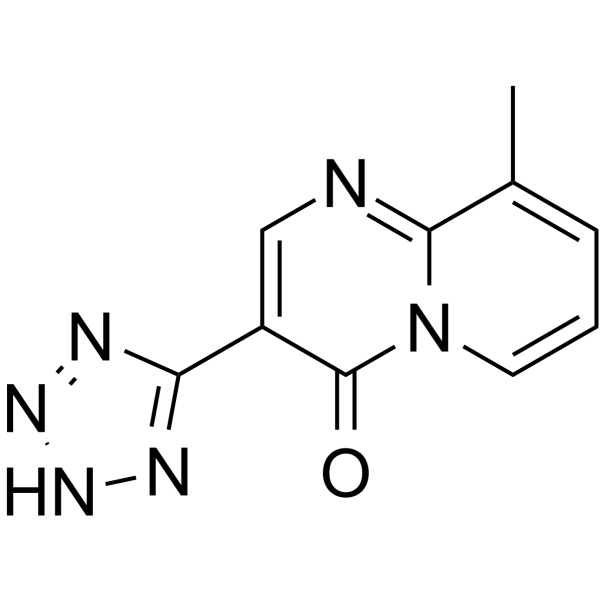
-
- HY-B1619
-
|
Cromoglicic acid
|
Others
|
Inflammation/Immunology
|
|
Cromolyn is a mast cell stabilizer. Cromolyn has the potential for the research of bronchial asthma, allergic rhinitis, and certain allergic eye conditions such as vernal conjunctivitis, keratitis, and keratoconjunctivitis .
|
-
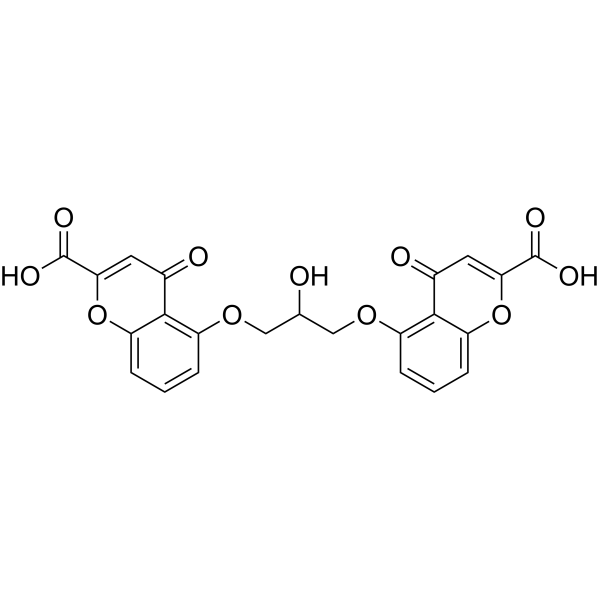
-
- HY-B1317
-
|
Neohetramine
|
|
|
|
Thonzylamine is an orally active H1 histamine receptor antagonist, exhibits good antihistaminic and antianaphylactic properties. Thonzylamine can be used for the research of hypersensitivity diseases, nasal congestion, allergic conjunctivitis and other allergic diseases .
|
-
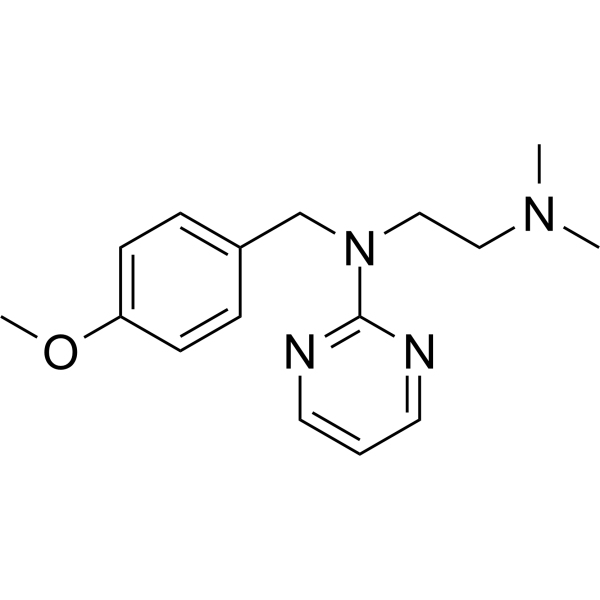
-
- HY-B1619S
-
|
Cromoglicic acid-d5
|
Isotope-Labeled Compounds
|
Inflammation/Immunology
|
|
Cromoglicic acid-d5 is the deuterium labeled Cromolyn[1]. Cromolyn is a mast cell stabilizer. Cromolyn has the potential for the research of bronchial asthma, allergic rhinitis, and certain allergic eye conditions such as vernal conjunctivitis, keratitis, and keratoconjunctivitis[2].
|
-

-
- HY-17428R
-
|
|
Histamine Receptor
Endogenous Metabolite
|
Inflammation/Immunology
Endocrinology
|
|
Tripelennamine (hydrochloride) (Standard) is the analytical standard of Tripelennamine (hydrochloride). This product is intended for research and analytical applications. Tripelennamine hydrochloride, an ethylenediamine derivative, is a potent histamine H1-receptor antagonist. Tripelennamine hydrochloride lessens the allergic response of the organism caused by histamine. Tripelennamine hydrochloride can be used for the research of rhinitis, conjunctivitis, and allergic and anaphylactic reactions .
|
-

-
- HY-17039
-
|
R89674
|
Histamine Receptor
|
Inflammation/Immunology
Endocrinology
|
|
Alcaftadine (R89674) is a histamine H1 receptor antagonist, which is used to prevent eye irritation brought on by allergic conjunctivitis. Alcaftadine is a broad-spectrum antihistamine displaying a high affinity for histamine H1 and H2 receptors and a lower affinity for H4 receptors. Alcaftadine also exhibits modulatory action on immune cell recruitment and mast cell stabilizing effects .
|
-
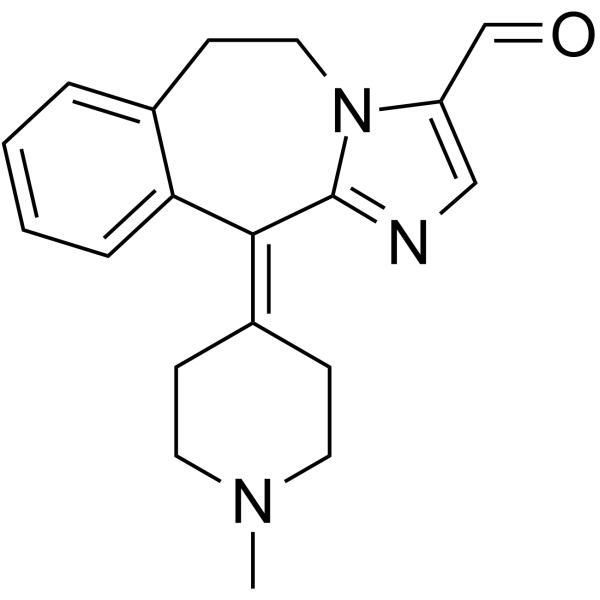
-
- HY-32067
-
|
Quinuclidin-3-yl acetate
|
mAChR
|
Neurological Disease
|
|
Aceclidine (Quinuclidin-3-yl acetate) is a modulator of M3 muscarinic acetylcholine receptor and a M1 receptor agonist (EC50: 40 μM). Aceclidine is a cycloplegic agent, a surfactant, a tonicity adjustor and optionally a viscosity enhancer and an antioxidant. Aceclidine has the potential for the research of disorders such as refractive errors of the eye, xerostomia, Sjogren's syndrome, glaucoma, conjunctivitis, lacrimal gland disease, and esotropia .
|
-

-
- HY-155782
-
|
|
RIP kinase
|
Inflammation/Immunology
|
|
Zharp2-1 is an oral effective RIPK2 inhibitor, highly associated with inflammatory bowel disease (IBD). Zharp2-1 blocker muramyl dipeptide (MDP) induces growth of mononuclear cells and induces inflammatory cell factor infection. Zharp2-1 attenuates MDP-induced small inguinal peritonitis, or ameliorates by DNBS-induced large inguinal conjunctivitis .
|
-
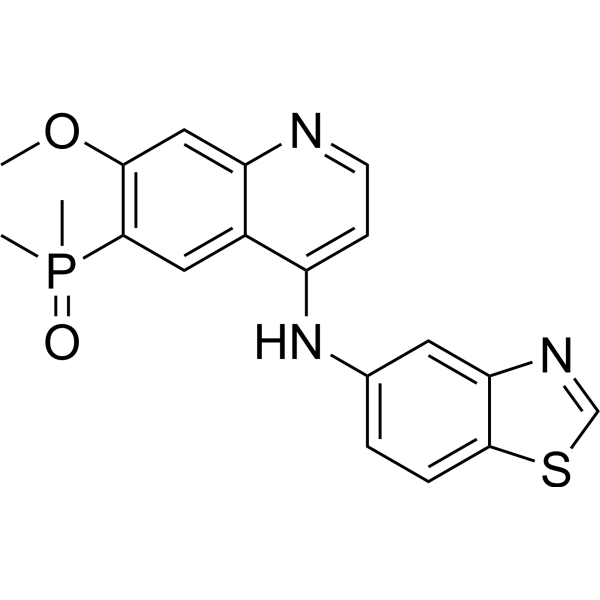
-
- HY-32067A
-
|
Quinuclidin-3-yl acetate hydrochloride
|
mAChR
|
Neurological Disease
|
|
Aceclidine (Quinuclidin-3-yl acetate) hydrochloride is a modulator of M3 muscarinic acetylcholine receptor and a M1 receptor agonist (EC50: 40 μM). Aceclidine hydrochloride is a cycloplegic agent, a surfactant, a tonicity adjustor and optionally a viscosity enhancer and an antioxidant. Aceclidine hydrochloride has the potential for the research of disorders such as refractive errors of the eye, xerostomia, Sjogren's syndrome, glaucoma, conjunctivitis, lacrimal gland disease, and esotropia .
|
-

-
- HY-10581AS
-
|
AM-1155-d3 hydrochloride; BMS-206584-d3 hydrochloride; PD135432-d3 hydrochloride
|
Isotope-Labeled Compounds
Bacterial
Topoisomerase
Antibiotic
|
Infection
|
|
Gatifloxacin-d3 (hydrochloride) is the deuterium labeled Gatifloxacin (hydrochloride). Gatifloxacin hydrochloride (AM-1155; BMS-206584; PD135432) is a potent fluoroquinolone antibiotic with broad-spectrum antibacterial activity. Gatifloxacin hydrochloride inhibits bacterial type II topoisomerases (IC50=13.8 μg/ml for S. aureus topoisomerase IV) and E. coli DNA gyrase (IC50 = 0.109 μg/ml). Gatifloxacin hydrochloride can be used to treat bacterial conjunctivitis in vivo.
|
-

-
- HY-B0455
-
|
SC47111A hydrochloride
|
Bacterial
Antibiotic
|
Infection
|
|
Lomefloxacin (SC47111A) hydrochloride is a broad-spectrum quinolone antibiotic, with antimicrobial activity. Lomefloxacin hydrochloride is used for the research of respiratory tract infections, genitourinary infections, gastrointestinal infections, ENT infections, etc. .
|
-
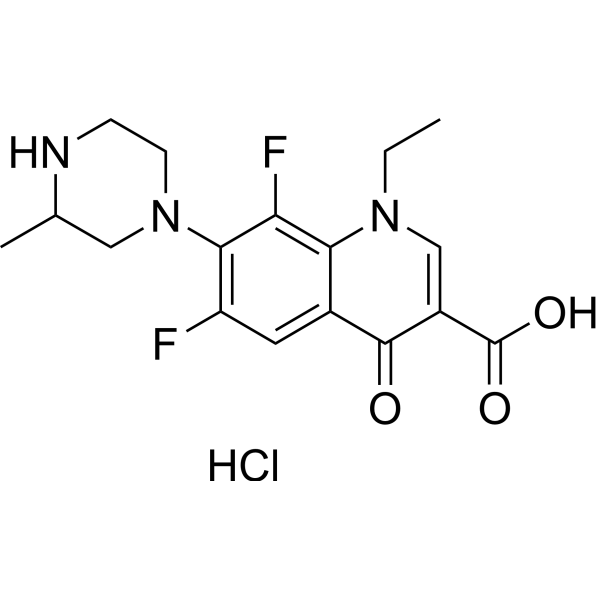
-
- HY-B0455A
-
|
SC47111A
|
Bacterial
Antibiotic
|
Infection
|
|
Lomefloxacin (SC47111A) is a broad-spectrum quinolone antibiotic, with antimicrobial activity. Lomefloxacin is used for the research of respiratory tract infections, genitourinary infections, gastrointestinal infections, ENT infections, etc. .
|
-
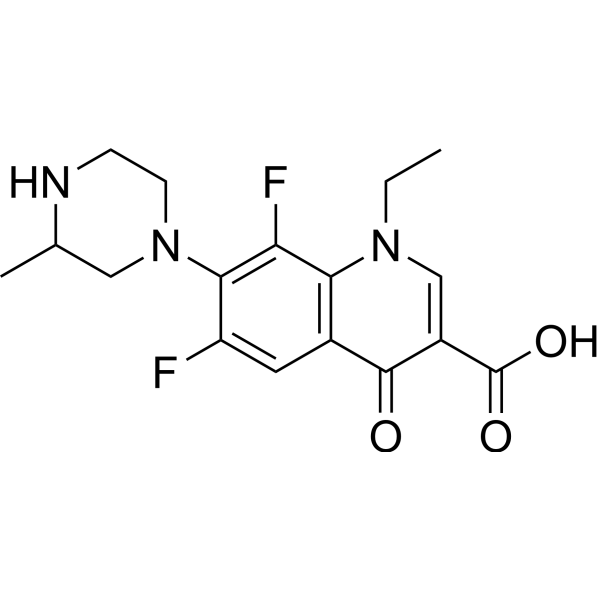
| Cat. No. |
Product Name |
Category |
Target |
Chemical Structure |
| Cat. No. |
Product Name |
Chemical Structure |
-
- HY-B0426AS
-
|
|
|
Olopatadine-d3 (hydrochloride) (ALO4943A-d3) is the deuterium labeled Olopatadine hydrochloride. Olopatadine hydrochloride (ALO4943A) is a histamine blocker used to treat allergic conjunctivitis[1][2].
|
-

-
- HY-108411S
-
|
|
|
Emedastine- 13C,d3 (fumarate) is the 13C- and deuterium labeled Emedastine. Emedastine is an orally active, selective and high affinity histamine H1 receptor antagonist with a Ki value of 1.3 nM. Emedastine is a benzimidazole derivative with potent antiallergic properties and used for allergic rhinitis, allergic skin diseases and allergic conjunctivitis[1][2][3].
|
-

-
- HY-W062109S
-
|
|
|
Olopatadine-d6 is the deuterium labeled Olopatadine[1]. Olopatadine is an orally active and selective histamine 1 (H1) receptor antagonist and a mast cell stabilizer. Olopatadine prevents immunologically stimulated pro-inflammatory mediator release from human conjunctival mast cells. Olopatadine can be used for researching allergic conjunctivitis[2][3].
|
-

-
- HY-B1619S
-
|
|
|
Cromoglicic acid-d5 is the deuterium labeled Cromolyn[1]. Cromolyn is a mast cell stabilizer. Cromolyn has the potential for the research of bronchial asthma, allergic rhinitis, and certain allergic eye conditions such as vernal conjunctivitis, keratitis, and keratoconjunctivitis[2].
|
-

-
- HY-10581AS
-
|
|
|
Gatifloxacin-d3 (hydrochloride) is the deuterium labeled Gatifloxacin (hydrochloride). Gatifloxacin hydrochloride (AM-1155; BMS-206584; PD135432) is a potent fluoroquinolone antibiotic with broad-spectrum antibacterial activity. Gatifloxacin hydrochloride inhibits bacterial type II topoisomerases (IC50=13.8 μg/ml for S. aureus topoisomerase IV) and E. coli DNA gyrase (IC50 = 0.109 μg/ml). Gatifloxacin hydrochloride can be used to treat bacterial conjunctivitis in vivo.
|
-

Your information is safe with us. * Required Fields.
Inquiry Information
- Product Name:
- Cat. No.:
- Quantity:
- MCE Japan Authorized Agent:















































